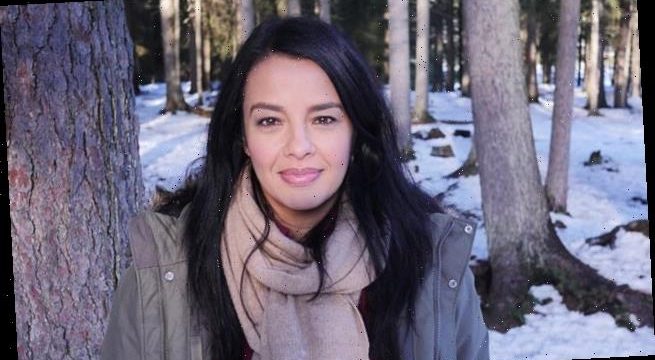CHRISTOPHER STEVENS reviews last night’s TV: This snowy delight made the perfect feast of TV leftovers
Snow Animals
Rating:
The Trial Of Christine Keeler
Rating:
Zipped into layers of puffer jackets like a parcel swaddled in bubble wrap, wildlife presenter Liz Bonnin was recording her pieces to camera at minus 33c on Snow Animals (BBC1).
Glimpses of ice-crusted creatures kept interrupting her: rabbits with frozen whiskers, bears dusted with snowflakes like icing sugar, that sort of thing.
Unfortunately, and there was no way Liz could have predicted this, Britain doesn’t seem to be bothering with winter this year. Many trees are already in bud, and there has been barely a snowflake.
It’s not just here. In Moscow, deliveries of artificial snow are being brought in by truck to make Red Square look picturesque
Wildlife presenter Liz Bonnin was recording her pieces to camera at minus 33c on Snow Animals
The Arctic foxes and snowshoe hares in Russia, busily growing their fur white for winter camouflage, are going to wish they hadn’t bothered.
Even the Antarctic was hotting up — especially in the middle of the penguin huddle where, Liz assured us, the birds’ bodies can reach 37c (100f).
That’s almost a sauna. Their black-and-white plumage did look lovely, though, glowing green under the spectral aurora.
Like a bubble-and-squeak made from uneaten roasties, sprouts, even that swede nobody wanted, Snow Animals was concocted from reheated leftovers.
The BBC’s wildlife unit has shot thousands of hours of high-definition video all over the world for this year’s spectaculars, such as Seven Worlds, One Planet. Much of it simply couldn’t be squeezed in, but letting it go to waste would be tragic. This compilation made good use of the offcuts.
We saw stunning shots of snow leopards, bobcats and polar bears, all filmed in the remotest icy wilderness. A mother sea otter kept her baby afloat in water so cold it looked like slush, by blowing into his fur till he became a pom-pom bobbing on the waves.
First class ride of the night:
Like any old loco, the steam train on the line from Fort William to Mallaig, on World’s Most Scenic Railway Journey (C5), took a while to get going. But half an hour in, the landscape of lochs and mountains was just magical.
In the mountains of southern China, snub-nosed monkeys snuggled up for warmth. Their fat, pink lips gave them the look of a gaggle of Love Islanders fresh from their collagen injections.
Liz demonstrated why monkeys cluster together on their snowy perches, by gathering mugs of hot chocolate together. The ones at the middle stayed hottest.
Simple explanations like this used to be the norm on TV, thanks to programmes such as Tomorrow’s World. These days, most presenters opt for high-tech graphics and CGI, not realising that complex scientific exposition is quickly forgotten.
I like the Bonnin approach: she isn’t condescending but she doesn’t overestimate the audience’s intelligence either, which at this time of year is very wise. A diet of unremitting mince pies and sherry doesn’t do anything to sharpen the wits.
Maybe the surfeit of calories steeped in alcohol is to blame, but the ping-ponging chronology in The Trial Of Christine Keeler (BBC1) is hard to follow.
As the first episode on Sunday ricocheted between years in the early Sixties, I told myself this echoed the dizziness of the era.
But the second part abandoned all pretence at logical order. With each scene, it was impossible to know whether what we’d already watched was in the past or yet to happen.
This story should have been told much more simply, in the order of events.
We could have begun with the first meeting between Stephen Ward and Christine Keeler at a Soho nightclub, and concentrated on the unfolding catastrophe — instead of wondering: ‘Haven’t they already met?’ and ‘Is this before or after she talked to that reporter?’
Source: Read Full Article



